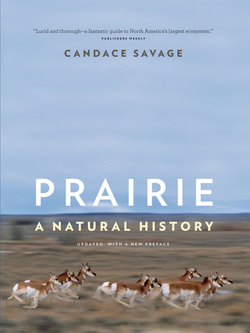Читать книгу Prairie - Candace Savage - Страница 31
На сайте Литреса книга снята с продажи.
ОглавлениеThree-flowered avens, seen in bud at left, is also known as prairie smoke or old man’s beard in tribute to its feathery seedheads, seen here.
But inevitably, on a planet where change is the only constant, their success was fleeting. By 13,000 years ago, the fabulous array of large mammals that the newcomers had encountered on the plains was already disappearing. As many as fifty species—including giant beavers, ground sloths, lions, cheetahs, dire wolves, saber-toothed cats, horses, camels, mammoths, and mastodons—all became extinct within a few thousand years. Did an exploding population of well-fed humans hunt the animals into oblivion, as some archaeologists suggest? Or was climate change the culprit? The evidence suggests that, between about 13,000 and 10,000 years ago, average global temperatures first dropped abruptly and then rebounded. On the North American plains, these climatic changes ultimately translated into a dramatic shift in vegetation patterns. Pushed by warmer, drier conditions, the spruce forests gave way to pines, then in places to open, mixed woodlands, and ultimately to grass. In the blink of an eye (relatively speaking), a carpet of grasses spread out across the plains, blued by sage and beardtongue and enlivened by patches of golden beans, blazing stars, and prairie smoke, or three-flowered avens. The prairies of historic times had finally been created.
Until quite recently (geologically speaking), North America was home to many different kinds of pronghorns— some diminutive, some with multiple horns. The modern species is the only one to survive the extinction crisis at the end of the Ice Age.
Although the species is old as the hills, researchers are only now beginning to map their preferred calving grounds and seasonal migrations.
This new grassland was big and bold, but it was also much less varied than the mixed landscape of tundra, grass, and forest that it had displaced. And perhaps this in itself is enough to explain the disappearance of the Ice Age megamammals, which required a rich and varied supply of foods that grasslands alone could not provide. Yet if the new habitats were insufficient to sustain mammoths, they appeared perfectly suited to the bison, which soon emerged as the dominant grazing animal on the open range.
As the great herds drummed across the prairie, they of course had no conception of how their homeland had been shaped. The evidence of that drama lay unnoticed beneath their hooves—long-buried evidence of onrushing seas, rising mountains, silt-burdened rivers, and towering cliffs of ice. But the bison were untroubled by the traumas of the past, as they flowed across the horizon toward the present.
> THE CREATION OF BEAR BUTTE, MONTANA
This a northern Cheyenne story, as told by Jessie Beaverheart American Horse of Lame Deer, Montana. Once there was a very beautiful young woman, whose father was determined to choose the right husband for her. Many men came to ask for her, but her father turned them all away. Finally, a tall, handsome young man, with two fine bay horses, appeared. “I am Cheyenne,” he proclaimed. “I have been a Cheyenne as long as there have been Cheyennes.” Although the father found him mysterious, he presented the young man to his daughter, who happily agreed to marry him.
After a while, the new husband told his wife, “There is one thing you must never do. Never turn your back on me.” He refused to explain this rule except to say that something terrible would happen if she ever broke it.
A year passed and the couple had a son. When the child was just a few months old, his father started teaching him how to ride. The mother protested—the baby was too young—and when her husband refused to listen, she snatched the infant and ran. “I told you never to turn your back on me!” the man howled, and he took off after them. When the woman looked back, she discovered that she was being pursued not by a man but by a grizzly bear.
Desperate, she ran to the top of a little mound and called out to Maheo, Above Person, for help. Right away, the hill began to lift up into the air, carrying the woman and child to safety. By the time the bear reached the hill, it was too steep and slippery for him to climb. Today, you can still see the marks left by his claws as he tried to scramble up the butte and, if the light is right, you can even make out the moccasin tracks of the woman and little boy. It is one of the places in the old Cheyenne country where women can look for power.
